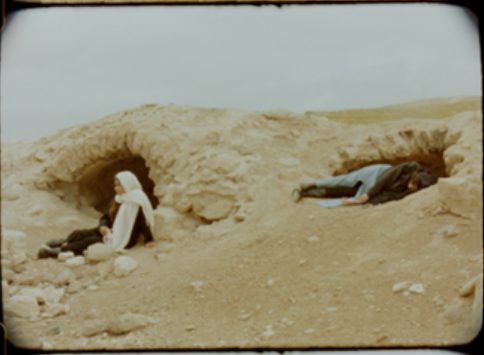
Reviewed by Goh Cheng Hao
In film, where landscapes are often (quite literally) backgrounded or peripheral, the Palestinian landscape instead takes centrality in Noor Abed’s short film, A Night We Held Between. The film won the Han Nefkens Foundation – Fundació Antoni Tàpies Video Art Production Grant in 2022, and was screened at the NTU Centre for Contemporary Art Singapore in January early this year.
Abed incorporates aspects of slow cinema into her art film: it lacks a central narrative, comprising long-drawn takes and a minimal soundscape consisting of indecipherable murmuring and reverberations interspersed with the occasional folk song. Nevertheless, its central message is unmistakable through its oblique imagery: A Night compellingly asserts the humanity of land, as an archive of the Palestinian people.
Land is the clear subject of the A Night. Throughout its thirty minute runtime, we see various scenes of the Palestinian landscape. Filmed in its ancient sites near the village of Al Jib (الجيب), the film introduces us to Palestine’s vast topography – through the camera’s movement, we traverse dark subterranean labyrinths, hills and valleys pockmarked with caves, mineral runoffs from erosion. Figures roam the rocky passages, their hands grazing rock overhangs and sandy floors; three women ambulate around a fire in a synchronised rhythmic dance flanked by the Palestinian landscape.
While Abed’s landscapes, in the absence of human subjects, seemingly evoke the impersonal and scientific realms of geography and geology. The film, however, contends otherwise: the land is so undeniably human – indelibly transformed by its past and present occupants, in the winding roads weathered by countless feet, and in horizons dotted with the ruins of buildings and cemeteries.
In another scene, figures lay in the recesses of holes, the ground moulding around their bodies, and we see shots from the insides of underground caves. In correspondence with Abed, she mentions precisely how these natural caves systems used to be extensively used as dwellings; a church with a cross carved on the stone inside, as houses, pharmacies, storages for wine and olives, and as graves. We hear heavy breaths during these scenes, distorted murmurs and whispers, as if the echoes and spectres of past inhabitants. The past continues to occupy these spaces, asserting the persistence of the human spirit.
A Night hence excavates the histories and human ties to the land, and perhaps most importantly, appeals to us how land is not inert nor indifferent to its occupants, but exists as a site of communal memory. In this way, the land archives human history.
A Night further explores this concept of land as archive, ruminating on the subject of cemeteries. Graves and cemeteries are not only literally grounded in the land itself, part of the landscape that records generational history, and Abed also observes how their accompanying rites of death and mourning necessarily interact with the landscape: Palestinian ritual dances and chants use the environment to amplify their sound.
Further, the film also obliquely points to it as the target of Israeli necroviolence (which Jason De León terms as violence performed through the specific treatment of corpses that is offensive, sacrilegious, or inhumane).
Particularly, one scene presents shots of graves while a disembodied singer croons a folk song: “As long as you are gone and not here…Perhaps our beloved will return / O handsome one, they created a barrier between us”. The scene reads as a lament for the Palestinian people lost to Israel’s genocidal violence and the partitioning of the Palestinian land, but is also evocative of Israeli mistreatment of cemeteries and the dead.
Sacred places such as the Mamilla (مقبرة مأمن الله) and Bab Al-Rahmeh cemeteries (مقبرة باب الرحمة) in Jerusalem and many others in the Gaza Strip currently have been razed, Palestinian bodies are unreasonably withheld from their families and martyrs are buried in cemeteries maqaber al-arqam (the cemeteries of numbers).1 In such an unassuming scene, A Night is able to evoke the inhumanity and injustice of Israeli colonial and expansionist ideology, as one that dehumanises Palestinians and violently displaces them (living and dead) from their homelands, neglecting the instrumentality and significance of land in Palestinian history and in mourning traditions and rituals.
Hamdan Taha’s essay on the ethnography of death in Palestine observes the centrality of location in Palestinian mortuary practices: “There is nothing severe as death far away from home”. The lack of bodies to mourn and to perform burial rites on also causes “ambiguous loss”, delaying the process of grief and eliminating the possibility for closure, a form of necroviolence that is “seemingly without end”2, to which the anonymous voice echoes: “Mourning and wailing are forbidden for me / As long as you are gone and not here”.
In this way, despite the simplicity of its imagery, A Night is able to explore how incredibly violent the dislocation of the Palestinian people is, dislocating them from their families, histories, but also from achieving spiritual rest.
While seemingly slow and anticlimactic, what A Night does extremely well is its ability to incite curiosity, eluding the boredom of slow cinema evident in many of its contemporaries.
Compared to other art films, A Night is able to strike a fine balance between unintelligibility and being overly didactic with its themes. The slow cinema genre’s unintelligibility and imposed introspection can tend to alienate its audience: the genre’s silences and its de-dramatised long shots allow for a transcendental or spiritual contemplation within its audience. However, when overly decontextualised, symptomatic in a few of Apichatpong Weerasethakul’s short films Vapour, M Hotel and Emerald that were screened at the S.E.A. Focus Fringe Film Programme: OFF Focus 2024, the complete inaction bores rather than intrigues.
On the other end of the spectrum, Ho Tzu Nyen’s art film Critical Dictionary of Southeast Asia that was screened at his Time and the Tiger exhibition, hits viewers over the head with its overload of information and theory. Ho’s work is similarly alienating, the over-explicit explanations render the audience passive and overwhelmed.
This is where Abed’s A Night shines, the film is oblique, ambiguous but without alienating, instead fostering contemplation. And yet, its coded messages on the injustices faced by the Palestinian people are also necessarily recognisable rather than completely unintelligible, able to activate audiences to act upon their curiosity, and clearly succeeded in doing so, prompting my research into this film.
Abed uses this slowness to provide respite from the inundation of images of abject violence and Palestinian suffering. In doing so, not dismissing them, but allowing us to see past these images, to remember the humanity of the Palestinian people, not just numbers or statistics, but people in their own right, with their own stories and lives.
And perhaps such a strategy is perhaps entirely necessary when dealing with the atrocities and injustice faced by the Palestinian people every day, for as Jacques Ranciere states: “If horror is banalized, it is not because we see too many images of it. We do not see too many suffering bodies on the screen. But we do see too many nameless bodies, too many bodies incapable of returning the gaze that we direct at them, too many bodies that are an object of speech without themselves having a chance to speak”.
Abed precisely does the opposite, allowing these images – of the land, of its people, of its histories and stories, its poetry, folk songs and myths – to speak for themselves.
In A Night We Held Between, the wind breathes through the vocal passageways of underground caves, singing the stories of its past inhabitants.
Click Here For More Film Reviews
Do you love writing? Send us a film review and we will feature it on our website. Any film that people can see in the theater or online. Email to: media@scape.sg
This review is also published on Singapore Film Society as part of *SCAPE’s Film Critics Lab: A Writing Mentorship Programme.

